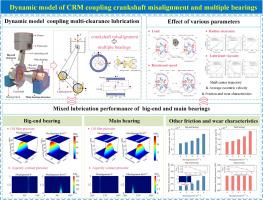多间隙润滑下曲轴不对中对轴承摩擦动力学的影响
IF 9.4
1区 工程技术
Q1 ENGINEERING, MECHANICAL
International Journal of Mechanical Sciences
Pub Date : 2025-10-04
DOI:10.1016/j.ijmecsci.2025.110917
引用次数: 0
摘要
现有的曲轴连杆机构动力学模型主要关注活塞发动机的单间隙润滑,难以分析多间隙协同下曲轴不对中与轴承混合润滑的耦合效应。本研究提出了一种集成多间隙润滑的新型动力学模型。基于曲柄和连杆的广义坐标,包括两个方向的不对准角,同步计算了大端和主轴承三维润滑场的动态边界条件,并将其纳入混合弹流润滑(MEHD)模型,对摩擦性能进行了评价。采用拉格朗日方法和变步长四阶龙格-库塔(VRK4)方法推导了运动方程,以解决多间隙不对准下的数值失稳问题。此外,还研究了操作参数和不对准对轴承摩擦磨损特性的耦合影响。结果表明:曲轴失位显著增加了体积磨损率和摩擦功率损失,在低速、高负荷工况下影响更为明显;适当的轴承间隙和润滑粘度可以帮助减轻不对准的不利影响。该研究为活塞式发动机轴承的分析和设计提供了一个高精度的仿真框架,并阐明了轴承错中故障机理。本文章由计算机程序翻译,如有差异,请以英文原文为准。

Crankshaft misalignment effect on bearing tribo-dynamics under multi-clearance lubrication
Existing dynamic models of the crank-connecting rod mechanism (CRM) primarily focus on single clearance lubrication in piston engines, making it difficult to analyze the coupled effects of crankshaft misalignment and mixed lubrication of bearings under multi-clearance collaboration. This study proposes a novel dynamic model that integrates multi-clearance lubrication. Based on the generalized coordinates of the crank and connecting rod, including misalignment angles in two directions, the dynamic boundary conditions of the three-dimensional lubrication fields of the big-end and main bearings are calculated synchronously, and incorporated into a mixed elasto-hydrodynamic lubrication (MEHD) model to evaluate the friction performance. The motion equations are derived using the Lagrange method with a variable-step fourth-order Runge-Kutta (VRK4) method to address numerical instability under multi-clearance misalignment. Furthermore, the coupled effects of operating parameters and misalignment on the friction and wear characteristics of the bearings are examined. The results show that crankshaft misalignment significantly increases the volumetric wear rate and friction power loss, with more pronounced effects under low-speed, high-load conditions. Appropriate bearing clearance and lubrication viscosity can help mitigate the adverse effects of misalignment. This study provides a high-precision simulation framework for analyzing and designing piston engine bearings and elucidates the misalignment fault mechanisms.
求助全文
通过发布文献求助,成功后即可免费获取论文全文。
去求助
来源期刊

International Journal of Mechanical Sciences
工程技术-工程:机械
CiteScore
12.80
自引率
17.80%
发文量
769
审稿时长
19 days
期刊介绍:
The International Journal of Mechanical Sciences (IJMS) serves as a global platform for the publication and dissemination of original research that contributes to a deeper scientific understanding of the fundamental disciplines within mechanical, civil, and material engineering.
The primary focus of IJMS is to showcase innovative and ground-breaking work that utilizes analytical and computational modeling techniques, such as Finite Element Method (FEM), Boundary Element Method (BEM), and mesh-free methods, among others. These modeling methods are applied to diverse fields including rigid-body mechanics (e.g., dynamics, vibration, stability), structural mechanics, metal forming, advanced materials (e.g., metals, composites, cellular, smart) behavior and applications, impact mechanics, strain localization, and other nonlinear effects (e.g., large deflections, plasticity, fracture).
Additionally, IJMS covers the realms of fluid mechanics (both external and internal flows), tribology, thermodynamics, and materials processing. These subjects collectively form the core of the journal's content.
In summary, IJMS provides a prestigious platform for researchers to present their original contributions, shedding light on analytical and computational modeling methods in various areas of mechanical engineering, as well as exploring the behavior and application of advanced materials, fluid mechanics, thermodynamics, and materials processing.
 求助内容:
求助内容: 应助结果提醒方式:
应助结果提醒方式:


